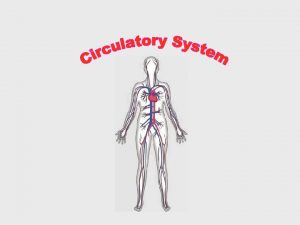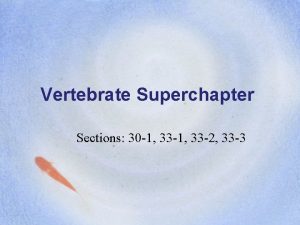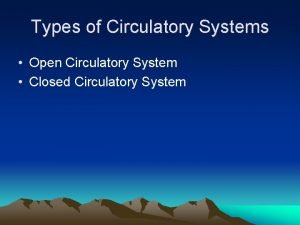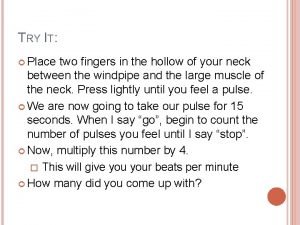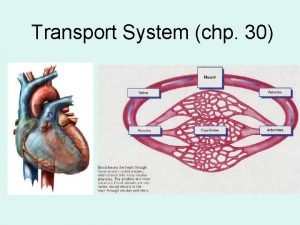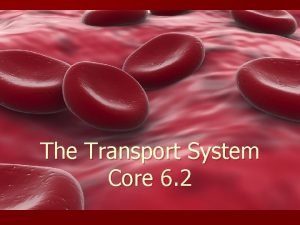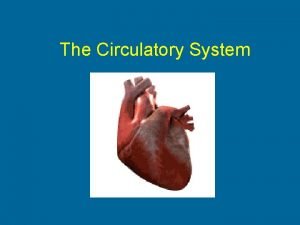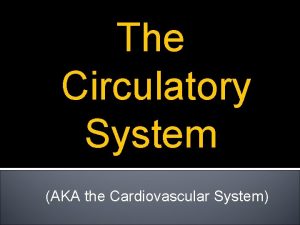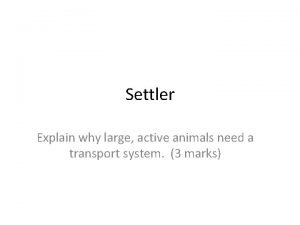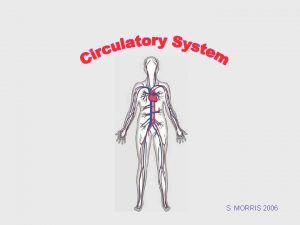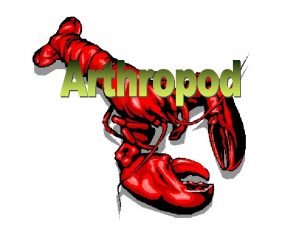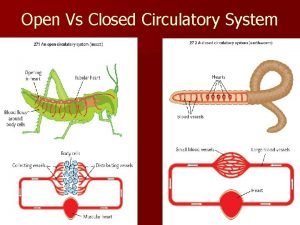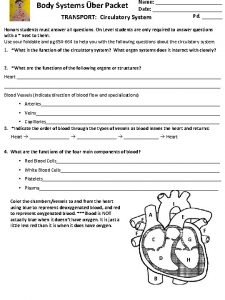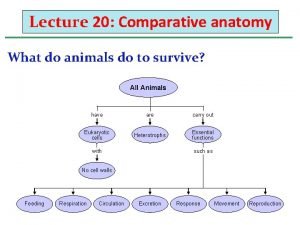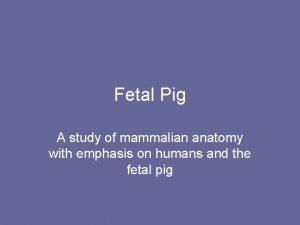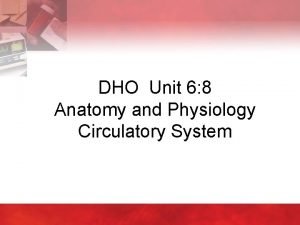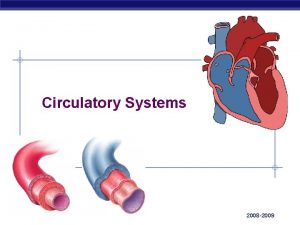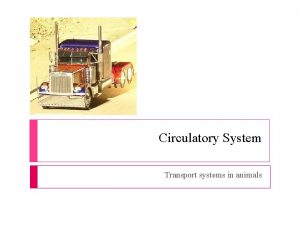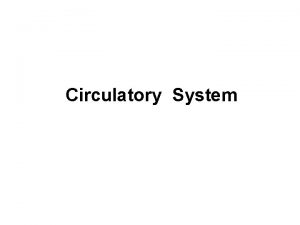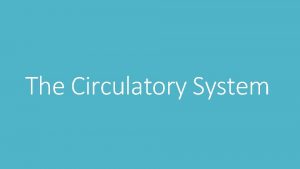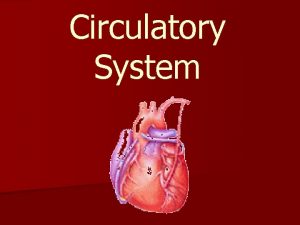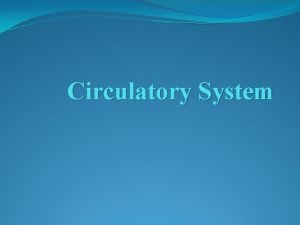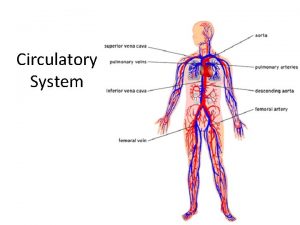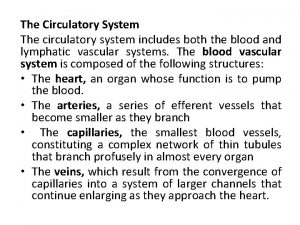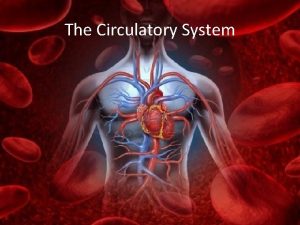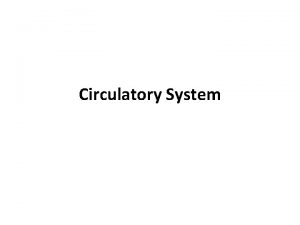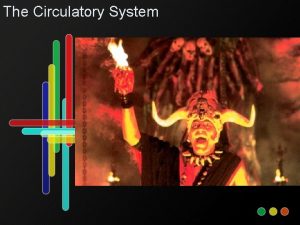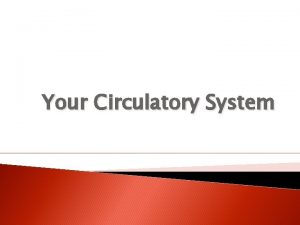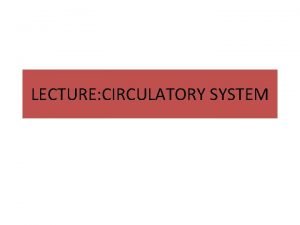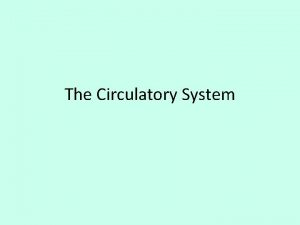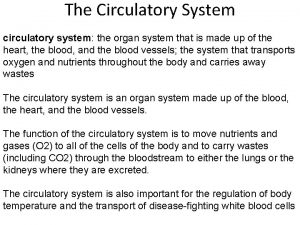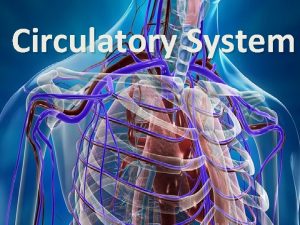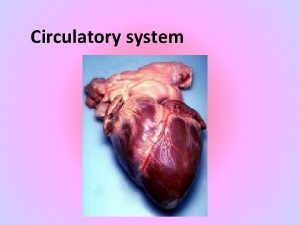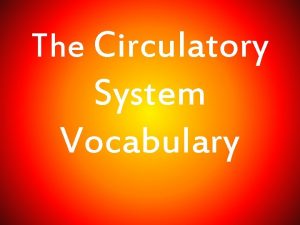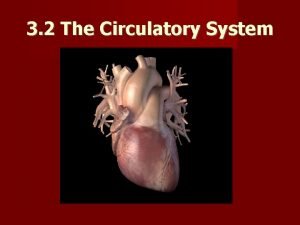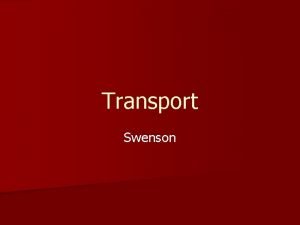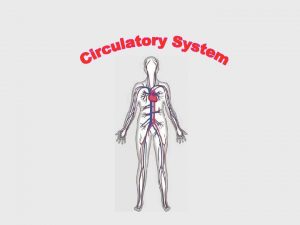The Circulatory System The circulatory system includes the



























- Slides: 27

The Circulatory System The circulatory system includes the Heart, Blood Tissue and the Blood Vessels.

The Circulatory System. Transport • The absorption and circulation of materials throughout an organism

Functions of the Circulatory System: 1) Transport of needed substances to body cells. (oxygen, amino acids, glucose, fatty acids, glycerol, salts, etc. ) to all body cells. 2) Carries carbon dioxide and other waste products away from cells. * In general, the blood is a fluid tissue helping to maintain homeostasis for all cells in the body.

The heart functions as a double pump beating in unison. 1) Deoxygenated blood--relatively low in oxygen 2) Oxygenated blood--relatively high in oxygen ** Heartbeat is stimulated by a. N electrochemical impulse. Pacemaker - in the right atrium - initiates the heartbeat


The Human (Mammalian) Heart Structure 1. septum: eptum muscular central wall dividing the mammalian heart into two halves 2. atria: atria thin walled upper heart chambers which receive blood pump blood to the ventricles 3. Ventricles: Ventricles muscular thick walled chambers which pump blood from the heart -- the lower chambers 4. Valves - prevent the backward flow of blood in the heart




Flow of blood (deoxygenated) 1. Inferior & superior vena cava 2. Right atrium 3. valve 4. Right ventricle 5. valve 6. Pulmonary arteries (BLOOD TO THE LUNGS –GAS EXCHANGE) …(oxygenated) 7. Pulmonary veins 8. Left Atrium 9. valve 10. Left ventricle 11. valve 12. Aorta

Blood Vessels Arteries * carry blood away from the heart * all except the pulmonary artery carry oxygenated blood * thick walled and elastic Pulse: Pulse expansion and contraction of the artery walls in response to the heartbeat


Veins * carry blood toward the heart * contain valves * closer to the body surface than the arteries * all except the pulmonary vein carry deoxygenated blood * thinner, less muscular and elastic than arteries * depend upon muscle and diaphragm movements for blood flow


Capillaries * most numerous of blood vessels * connect arteries to veins * microscopic, one cell thick walls * site of much exchange between the blood and the intracellular fluid (lymph) by diffusion

Which Way Did it Go?

Blood = a connective tissue made up of blood cells and a liquid called blood plasma. About 7 % of your body mass About 4. 5 - 5. 6 Liters in an adult human Men = 5. 6 Liters Women = 4. 5 Liters Pregnant woman = 5. 0 Liters

The Functions of Blood Delivers: Nutrients Oxygen, Water, minerals Hormones and enzymes pollutants Picks Up: - waste kidneys - carbon dioxide lungs - heat skin

The Parts of Blood 1. Plasma =carries everything 2. Red Blood Cells =(RBC) gas exchange 3. White blood Cells =(WBC) fight infection 4. Platelets = clotting

Blood Composition • Plasma 55% (liquid part of the blood); Blood Cells 45%

55% plasma 45 % RBC, WBC and platelets

Plasma- nonliving • Yellow liquid (92% H 2 O) • 8 % nutrients, salts, urea, hormones • Carries: RBC, WBC, Platelets, Carbon dioxide, food and waste

• Red Blood Cells (Erythrocytes) – most numerous – disc shaped – smaller than white blood cells, larger than platelets – produced in the red marrow of long bones – destroyed in the liver and spleen – contain the iron protein compound HEMOGLOBIN whose chief function is to combine with oxygen and carry it to the cells

White Blood cells (Lymphocytes or Leukocytes) --largest blood cells--several different types --about 8, 000 per drop of blood --most are formed in the bone marrow or in the lymph tissue --most protect the body against diseases by forming antibodies or engulfing bacteria

Platelets --smallest blood cells (fragments) --150, 000 to 300, 000 per drop of blood --needed for clotting

Clotting: Involves a series of enzyme controlled reactions resulting in the formation of protein fibers that trap blood cells and form a clot.

Pacemaker- • Uses electrical impulses from wire leads inserted into the Heart. • Keeps the Heart in perfect rhythm.
 The circulatory system includes
The circulatory system includes Digestive system circulatory system and respiratory system
Digestive system circulatory system and respiratory system How respiratory system work with circulatory system
How respiratory system work with circulatory system Circulatory system and respiratory system work together
Circulatory system and respiratory system work together Circulatory system steps in order
Circulatory system steps in order Superchp
Superchp Lungfish circulatory system
Lungfish circulatory system Do clams have a closed circulatory system
Do clams have a closed circulatory system Horse heart
Horse heart Circulatory system function
Circulatory system function Closed circulatory system
Closed circulatory system Circulatory system jobs
Circulatory system jobs 3 parts of the circulatory system
3 parts of the circulatory system Active animals
Active animals How circulatory system work
How circulatory system work What makes up the cardiovascular system
What makes up the cardiovascular system Gas exchange oxygen transport
Gas exchange oxygen transport Single vs double circulatory system
Single vs double circulatory system Arthropoda insecta
Arthropoda insecta Crustaceans characteristics
Crustaceans characteristics Single vs double circulatory system
Single vs double circulatory system Circulatory system foldable
Circulatory system foldable Invertebrate circulatory system
Invertebrate circulatory system Fetal pig taxonomy
Fetal pig taxonomy Unit 6:8 circulatory system
Unit 6:8 circulatory system Open circulatory system
Open circulatory system Invertebrate circulatory system
Invertebrate circulatory system Circulatory system function
Circulatory system function




